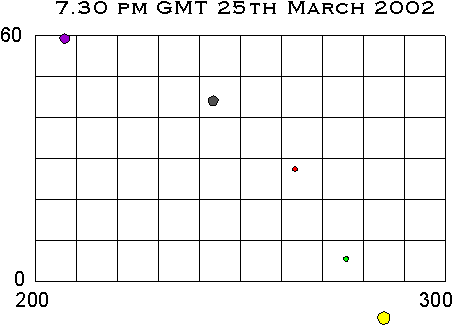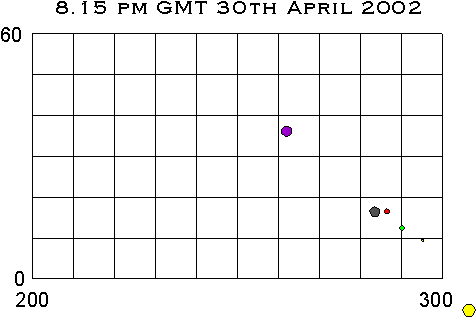
24th March 2002 George Burnett-Stuart writes:
Last Thursday (21st March), I happened to look up into the Western sky at about 10 in the evening. The moon was brilliant, just short of a half-moon, placed almost on a line between Saturn and Jupiter. The moon appeared to be holding out her arms to receive Jupiter. This reminded me of what the heavens have in store for us next month - a great gathering of the planets in the evening sky. This is a kind of aftermath of the gathering of the planets in May 2000. This time the gathering is not so tight, but because the planets will not be bunched up with the sun we will at least be able to see them! The reason we will have had to wait two years for the gathering to repeat itself (albeit more loosely) rather than just one year is that it takes Mars slightly more than two years to return to the same position, relative to the sun, as observed from the earth (the so called "synodic period" of Mars - see The Stars in their Courses ). One year ago, Mars was over in the opposite side of the sky from the Sun. Also, it so happens that Venus and even Mercury, with their shorter periods, will also be up there in the evening sky during April and early May. This is what Almagest indicates for the 15th April, 8.15 in the evening (that is, 8.15 by the clock, the same as 7.15 GMT):

The Sun has just set - it is just below the edge of the Horizon Plate (the semi-annulus which overlaps the rotating Zodiac Plate, marked with the symbols of the signs of the Zodiac). The crescent Moon is low in the Western Sky, very close to the planets Venus (green in the diagram), Mars (red) and Saturn (black). Mercury (small yellow ball) will not yet be visible, though it passed behind the Sun into the evening sky on the 7th April. Jupiter (purple) will be somewhat higher in the sky.

By the 30th of April, the four planets Mercury Venus Mars and Saturn will be pretty close together, and quite well up from the setting Sun. A good opportunity to observe Mercury (see the alt-azimuth diagram at the bottom of this page). Only Jupiter will be standing apart.

Here, on the 14th May we see the new Moon once more entangled with the planets, which have by now changed their positions relative to one another. Swift Mercury has turned back towards the sun. Venus has overtaken Mars, which has in turn overtaken ponderous Saturn - a beautiful illustration of the relative speeds of the planets, the very feature which determined the ordering of their spheres in the Ptolemaic System.
Note added 26th March
Looking to the West soon after sunset, Venus is now easily visible as evening star just above the horizon. Jupiter appears very soon after sunset as well, but high up in the sky. Slightly later, Saturn becomes visible, with the bright star Aldebaran (the Bull's Eye) close by. Note how the star twinkles but the planet does not. A while later Mars appears, roughly equidistant between Saturn and Venus, but to the North of a line drawn between them. The following alt-azimuth diagram shows one where to look. (Altitude is angle above the horizon, azimuth is angle round from North, measured from left to right - so due West corresponds to 270° of azimuth.)

(The yellow disc below the horizon represents the sun. Reading from left to right the planets are: Jupiter, Saturn, Mars, Venus.) The next diagram shows the situation at the end of April. Note tiny Mercury just below and to the right of Venus:

(Both diagrams drawn for 52N0E. Data obtained from the Almagest control box.)